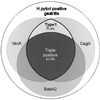Clinical relevance of the Helicobacter pylori gene for blood-group antigen-binding adhesin - PubMed (original) (raw)
Clinical relevance of the Helicobacter pylori gene for blood-group antigen-binding adhesin
M Gerhard et al. Proc Natl Acad Sci U S A. 1999.
Abstract
Infection with Helicobacter pylori is associated with different human gastric diseases. Biochemical studies, in vitro adherence assays, and in vivo animal models revealed that epithelial attachment of H. pylori can be mediated by the blood-group antigen-binding adhesin (BabA) targeting human Lewis(b) surface epitopes. Studies with transgenic mice expressing the Lewis(b) epitope have shown that such attachment can alter disease outcome. In the current study, the presence of the babA2 gene encoding the adhesin was investigated in clinical isolates from a German population by using PCR and reverse transcription-PCR. A positive genotype was correlated to allelic variations in the genes encoding VacA and CagA and also to the prevalence of duodenal ulcer, distal gastric adenocarcinoma, mucosa-associated lymphoid tissue lymphoma, and antral gastritis. The presence of babA2 was significantly associated with duodenal ulcer (P = 0.0002) and adenocarcinoma (P = 0.033). In contrast, type 1 strains (vacAs1- and cagA-positive) were associated with only duodenal ulcer (P = 0.004) but not adenocarcinoma (P = 0.235). Genotype presence of babA2, vacAs1, and cagA ("triple-positive" strains) showed a highly significant correlation to the prevalence of ulcer (P = 0.000002) and adenocarcinoma (P = 0.014) and discriminated significantly better between disease outcome than did the current type 1 classification. These results indicate that the babA2 gene is of high clinical relevance and would be a useful marker to identify patients who are at higher risk for specific H. pylori-related diseases.
Figures
Figure 1
BabA gene organization, nucleotide sequence (adapted from ref. 28), and primer positions for mismatch PCR. The binding of the sense primer to babA1 and babA2 genes is shown in relation to repeat motif. Matches are indicated by vertical bars; mismatches are indicated by asterisks. Regions of high homology to other genes (OMP9) are indicated by gray shading of open bars.
Figure 2
Schematic illustration of the distribution of vacAs1, cagA, and babA2 strains in a total of 35 H. pylori isolates from patients with gastritis.
Figure 3
babA2, type 1, and triple-positive genotypes in H. pylori isolates from patients with different diseases. GC, gastric adenocarcinoma; UD, duodenal ulcer.
Similar articles
- Association of Helicobacter pylori babA2 with peptic ulcer disease and gastric cancer.
Chen MY, He CY, Meng X, Yuan Y. Chen MY, et al. World J Gastroenterol. 2013 Jul 14;19(26):4242-51. doi: 10.3748/wjg.v19.i26.4242. World J Gastroenterol. 2013. PMID: 23864790 Free PMC article. Review. - Key importance of the Helicobacter pylori adherence factor blood group antigen binding adhesin during chronic gastric inflammation.
Prinz C, Schöniger M, Rad R, Becker I, Keiditsch E, Wagenpfeil S, Classen M, Rösch T, Schepp W, Gerhard M. Prinz C, et al. Cancer Res. 2001 Mar 1;61(5):1903-9. Cancer Res. 2001. PMID: 11280745 - No correlation of babA2 with vacA and cagA genotypes of Helicobacter pylori and grading of gastritis from peptic ulcer disease patients in Brazil.
Mattar R, dos Santos AF, Eisig JN, Rodrigues TN, Silva FM, Lupinacci RM, Iriya K, Carrilho FJ. Mattar R, et al. Helicobacter. 2005 Dec;10(6):601-8. doi: 10.1111/j.1523-5378.2005.00360.x. Helicobacter. 2005. PMID: 16302986 - Clinical relevance of the babA2 genotype of Helicobacter pylori in Japanese clinical isolates.
Mizushima T, Sugiyama T, Komatsu Y, Ishizuka J, Kato M, Asaka M. Mizushima T, et al. J Clin Microbiol. 2001 Jul;39(7):2463-5. doi: 10.1128/JCM.39.7.2463-2465.2001. J Clin Microbiol. 2001. PMID: 11427555 Free PMC article. - Roles of Helicobacter pylori BabA in gastroduodenal pathogenesis.
Yamaoka Y. Yamaoka Y. World J Gastroenterol. 2008 Jul 21;14(27):4265-72. doi: 10.3748/wjg.14.4265. World J Gastroenterol. 2008. PMID: 18666312 Free PMC article. Review.
Cited by
- Phylogeographic origin of Helicobacter pylori determines host-adaptive responses upon coculture with gastric epithelial cells.
Sheh A, Chaturvedi R, Merrell DS, Correa P, Wilson KT, Fox JG. Sheh A, et al. Infect Immun. 2013 Jul;81(7):2468-77. doi: 10.1128/IAI.01182-12. Epub 2013 Apr 29. Infect Immun. 2013. PMID: 23630959 Free PMC article. - Helicobacter pylori in gastric carcinogenesis: mechanisms.
Wroblewski LE, Peek RM Jr. Wroblewski LE, et al. Gastroenterol Clin North Am. 2013 Jun;42(2):285-98. doi: 10.1016/j.gtc.2013.01.006. Epub 2013 Mar 6. Gastroenterol Clin North Am. 2013. PMID: 23639641 Free PMC article. Review. - Association of Helicobacter pylori babA2 with peptic ulcer disease and gastric cancer.
Chen MY, He CY, Meng X, Yuan Y. Chen MY, et al. World J Gastroenterol. 2013 Jul 14;19(26):4242-51. doi: 10.3748/wjg.v19.i26.4242. World J Gastroenterol. 2013. PMID: 23864790 Free PMC article. Review. - Molecular analysis of Helicobacter pylori virulent-associated genes in hepatobiliary patients.
Boonyanugomol W, Chomvarin C, Sripa B, Chau-In S, Pugkhem A, Namwat W, Wongboot W, Khampoosa B. Boonyanugomol W, et al. HPB (Oxford). 2012 Nov;14(11):754-63. doi: 10.1111/j.1477-2574.2012.00533.x. Epub 2012 Aug 17. HPB (Oxford). 2012. PMID: 23043664 Free PMC article. - Identification of markers for Helicobacter pylori strains isolated from children with peptic ulcer disease by suppressive subtractive hybridization.
Oleastro M, Monteiro L, Lehours P, Mégraud F, Ménard A. Oleastro M, et al. Infect Immun. 2006 Jul;74(7):4064-74. doi: 10.1128/IAI.00123-06. Infect Immun. 2006. PMID: 16790780 Free PMC article.
References
- Covacci A, Telford J L, Del G G, Parsonnet J, Rappuoli R. Science. 1999;284:1328–1333. - PubMed
- Kersulyte D, Chalkauskas H, Berg D E. Mol Microbiol. 1999;31:31–43. - PubMed
Publication types
MeSH terms
Substances
LinkOut - more resources
Full Text Sources
Other Literature Sources


